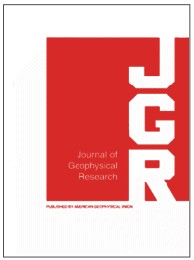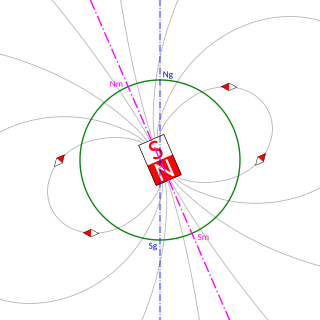Related Research Articles

Earth's magnetic field, also known as the geomagnetic field, is the magnetic field that extends from Earth's interior out into space, where it interacts with the solar wind, a stream of charged particles emanating from the Sun. The magnetic field is generated by electric currents due to the motion of convection currents of a mixture of molten iron and nickel in Earth's outer core: these convection currents are caused by heat escaping from the core, a natural process called a geodynamo.

Paleomagnetism is the study of magnetic fields recorded in rocks, sediment, or archeological materials. Geophysicists who specialize in paleomagnetism are called paleomagnetists.
The Brunhes–Matuyama reversal, named after Bernard Brunhes and Motonori Matuyama, was a geologic event, approximately 781,000 years ago, when the Earth's magnetic field last underwent reversal. Estimations vary as to the abruptness of the reversal. A 2004 paper estimated that it took over several thousand years; a 2010 paper estimated that it occurred more quickly, perhaps within a human lifetime; a 2019 paper estimated that the reversal lasted 22,000 years.
Allan Verne Cox was an American geophysicist. His work on dating geomagnetic reversals, with Richard Doell and Brent Dalrymple, made a major contribution to the theory of plate tectonics. Allan Cox won numerous awards, including the prestigious Vetlesen Prize, and was the president of the American Geophysical Union. He was the author of over a hundred scientific papers, and the author or editor of two books on plate tectonics. On January 27, 1987, Cox died in an apparent suicide.
A geomagnetic excursion, like a geomagnetic reversal, is a significant change in the Earth's magnetic field. Unlike reversals, an excursion is not a "permanent" re-orientation of the large-scale field, but rather represents a dramatic, typically a (geologically) short-lived change in field intensity, with a variation in pole orientation of up to 45° from the previous position.
A geomagnetic reversal is a change in a planet's magnetic field such that the positions of magnetic north and magnetic south are interchanged. The Earth's field has alternated between periods of normal polarity, in which the predominant direction of the field was the same as the present direction, and reverse polarity, in which it was the opposite. These periods are called chrons.
The Rhaetian is the latest age of the Triassic Period or the uppermost stage of the Triassic System. It was preceded by the Norian and succeeded by the Hettangian. The base of the Rhaetian lacks a formal GSSP, though candidate sections include Steinbergkogel in Austria and Pignola-Abriola in Italy. The end of the Rhaetian is more well-defined. According to the current ICS system, the Rhaetian ended 201.4 ± 0.2 Ma.

The Journal of Geophysical Research is a peer-reviewed scientific journal. It is the flagship journal of the American Geophysical Union. It contains original research on the physical, chemical, and biological processes that contribute to the understanding of the Earth, Sun, and Solar System. It has seven sections: A, B, C (Oceans), D (Atmospheres), E (Planets), F, and G (Biogeosciences). All current and back issues are available online for subscribers.

The Australasian strewnfield is the youngest and largest of the tektite strewnfields, with recent estimates suggesting it might cover 10%–30% of the Earth's surface. Research indicates that the impact forming the tektites occurred around 788,000 years ago, most likely in Southeast Asia.

Eocursor is genus of basal ornithischian dinosaur that lived in what is now South Africa during the Early Jurassic. Remains of this animal have been found in the Upper Elliot Formation and it is among the most completely known early ornithischians, shedding new light on the origin of the group.

The Vine–Matthews–Morley hypothesis, also known as the Morley–Vine–Matthews hypothesis, was the first key scientific test of the seafloor spreading theory of continental drift and plate tectonics. Its key impact was that it allowed the rates of plate motions at mid-ocean ridges to be computed. It states that the Earth's oceanic crust acts as a recorder of reversals in the geomagnetic field direction as seafloor spreading takes place.
Magnetostratigraphy is a geophysical correlation technique used to date sedimentary and volcanic sequences. The method works by collecting oriented samples at measured intervals throughout the section. The samples are analyzed to determine their characteristic remanent magnetization (ChRM), that is, the polarity of Earth's magnetic field at the time a stratum was deposited. This is possible because volcanic flows acquire a thermoremanent magnetization and sediments acquire a depositional remanent magnetization, both of which reflect the direction of the Earth's field at the time of formation. This technique is typically used to date sequences that generally lack fossils or interbedded igneous rock. It is particularly useful in high-resolution correlation of deep marine stratigraphy where it allowed the validation of the Vine–Matthews–Morley hypothesis related to the theory of plate tectonics.
Richard Doell was a distinguished American scientist known for developing the time scale for geomagnetic reversals with Allan V. Cox and Brent Dalrymple. This work was a major step in the development of plate tectonics. Doell shared the Vetlesen Prize with Cox and Dalrymple.
Grotte du Vallonnet is an archaeological site located near Roquebrune-Cap-Martin, between Monaco and Menton, in France, that was first discovered in 1958. Stone tools found at the site have been dated to between 1 and 1.05 million years old, making it one of the earliest sites of human settlement known in Europe.

The south magnetic pole, also known as the magnetic south pole, is the point on Earth's Southern Hemisphere where the geomagnetic field lines are directed perpendicular to the nominal surface. The Geomagnetic South Pole, a related point, is the south pole of an ideal dipole model of the Earth's magnetic field that most closely fits the Earth's actual magnetic field.

The geomagnetic poles are antipodal points where the axis of a best-fitting dipole intersects the surface of Earth. This theoretical dipole is equivalent to a powerful bar magnet at the center of Earth, and comes closer than any other point dipole model to describing the magnetic field observed at Earth's surface. In contrast, the magnetic poles of the actual Earth are not antipodal; that is, the line on which they lie does not pass through Earth's center.
The Laschamp or Laschamps event was a geomagnetic excursion. It occurred between 42,200 and 41,500 years ago, during the end of the Last Glacial Period. It was discovered from geomagnetic anomalies found in the Laschamps lava flows in Clermont-Ferrand, France in the 1960s.
Magnetic field reversal may refer to:
The Pignola-Abriola section is a ~63 m long stratigraphic sequence of cherty limestones deposited in the Lagonegro Basin during the latest Norian and the early Rhaetian Stages. The main outcrop is on the western side of Mount Crocetta along the SP5 road connecting the villages of Pignola and Abriola. A smaller outcrop, overlapping the central part of the main section, is located near a former railway tunnel, few meters below the road level. The Pignola-Abriola section has been recently proposed as GSSP of the Rhaetian Stage.

Dennis V. Kent is an American geologist and geophysicist who is a Board of Governors Professor Emeritus at Rutgers University and an adjunct senior research scientist at Lamont–Doherty Earth Observatory of Columbia University. His research focuses on paleomagnetism, geomagnetism, rock magnetism, and their application to geologic problems, including geologic time scales, paleogeography, ancient climate, polar wander, and the long-term carbon cycle.
References
- ↑ Cande, S.C., and D.V. Kent, Revised calibration of the geomagnetic polarity timescale for the late Cretaceous and Cenozoic, J. Geophys. Res., 100, 6,093-6,095, 1995.